Shaker communities
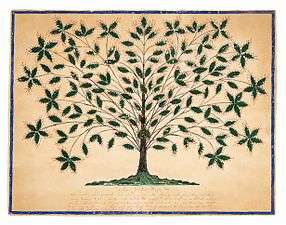 |
| Topics |
|---|
|
| Notable people |
|



After the Shakers arrived in the United States in 1774, they established numerous communities in the late-18th century through the entire 19th century. The first villages organized in Upstate New York and the New England states, and, through Shaker missionary efforts, Shaker communities appeared in the Midwestern states. Communities of Shakers were governed by area bishoprics and within the communities individuals were grouped into "family" units and worked together to manage daily activities. By 1836 eighteen major, long-term societies were founded, comprising some sixty families, and many smaller, short-lived communities were established over the course of the 19th century, including two failed ventures into the Southeastern United States and an urban community in Philadelphia, Pennsylvania. The Shakers peaked in population by the early 1850s. With the turmoil of the American Civil War and subsequent Industrial Revolution, Shakerism went into severe decline, and as the number of living Shakers diminished, Shaker villages ceased to exist. Some of their buildings and sites have become museums, and many are historic districts under the National Register of Historic Places. The only active community is Sabbathday Lake Shaker Village in Maine.
The first Shaker societies
The first Shaker community was established north of Albany, and was first called "Niskayuna", a rendering of the Indian name for the land. Later the town they were in was officially named Watervliet. That part of the town of Watervliet is now in the town of Colonie (since 1895), and the name Watervliet is now limited to the city of Watervliet (1896). In addition, Niskayuna is now the name of a town to the northwest. This has led to some confusion, because many historical accounts refer to them as the Niskayuna Shakers, while others refer to them as Watervliet Shakers. The Watervliet Shaker Historic District is where Mother Ann Lee was buried.[1]
By 1780, the missionary work of the Shakers had attracted many new converts. An extensive series of trips throughout New England from 1781 through 1783 brought in followers across the entire region. Converts began appearing in New Lebanon and Canaan, New York; Hancock, Pittsfield, Richmond, Ashfield, Harvard, and Shirley, Massachusetts; and the states of Connecticut, New Hampshire, and Maine (then part of Massachusetts), among other locations.
In 1784, Ann Lee and her brother both died, leaving James Whittaker to lead the faith. By 1787, he too had died, and Joseph Meacham assumed the role as leader. Meacham appointed Lucy Wright of Pittsfield to co-lead, and under their auspices they organized a central Village in New Lebanon, as well as organizing the original settlement of Watervliet. By 1790, the Hancock Village was also organized.
After the formation of the New Lebanon, Watervliet, and Hancock communities, within three years all remaining Northeastern communities would organize in Massachusetts, Connecticut, New Hampshire, and Maine.
Settlement growth
The Shakers built more than 20 settlements that attracted at least 20,000 converts over the next century.[2] Strict believers in celibacy, Shakers acquired their members through conversion, indenturing children, and adoption of orphans. Some children, such as Isaac N. Youngs, came to the Shakers when their parents joined, then grew up to become faithful members as adults.[3]
As their communities grew, women and men shared leadership of the Shaker communities. Women preached and received revelations as the Spirit fell upon them. Thriving on the religious enthusiasm of the first and second Great Awakenings, the Shakers declared their messianic, communitarian message with significant response. One early convert observed: “The wisdom of their instructions, the purity of their doctrine, their Christ-like deportment, and the simplicity of their manners, all appeared truly apostolical.” The Shakers represent a small but important Utopian response to the gospel. Preaching in their communities knew no boundaries of gender, social class, or education.[4]
Village organization
Bishoprics
Shaker communities were grouped into bishoprics, which were governing units. A ministry resided in the bishopric's primary community. The New Lebanon Bishopric, the primary bishopric unit, was located in New York and included the Mount Lebanon Shaker Society and the Watervliet Shaker Villages.[5]
Family groups
A Shaker village was divided into groups or "families." The leading group in each village was the Church Family, and it was surrounded by satellite families that were often named for points on the compass rose. Each village was governed by a leadership team consisting of two men (Elders) and two women (Eldresses). Shakers lived together as brothers and sisters. Each house was divided so that men and women did most things separately. They used different staircases and doors. They sat on opposite sides of the room in worship, at meals, and in "union meetings" held to provide supervised socialization between the sexes. However, the daily business of a Shaker village required the brethren and sisters to interact. Though there was a division of labor between men and women, they also cooperated in carrying out many tasks, such as harvesting apples, food production, laundry, and gathering firewood.[6]
Every family was designed to be self-supporting with its own farm and businesses, but in times of hardship, other Shaker villages pitched in to help the afflicted.
Communities
| Image | Site | Spiritual name[7] | Bishopric[5][8] | City | State | Dates | Historic designation |
|---|---|---|---|---|---|---|---|
 | Alfred Shaker Village | Holy Land | Alfred[nb 1] | Alfred | Maine | 1793-1931[9][10] | NRHP[11][nb 2] |
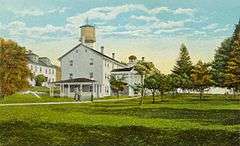 | Canterbury Shaker Village | Holy Ground | Canterbury | Canterbury | New Hampshire | 1792-1992[12][13] | NRHP[11] |
| | New Enfield Shaker Village | Chosen Vale | Canterbury | Enfield | New Hampshire | 1793-1923[14][15] | NRHP[11] |
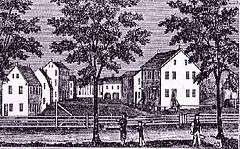 | Old Enfield Shaker Village | City of Union | Hancock | Enfield | Connecticut | 1792-1917[16][17] | NRHP[11] |
| Gorham Shaker Village | Union Branch | Alfred | Gorham | Maine | 1808-1819[18] | ||
 | Groveland Shaker Village | Union Branch | Groveland[nb 3] | Groveland | New York | 1836-1892[19] | |
.jpg) | Hancock Shaker Village | City of Peace | Hancock | Hancock and Pittsfield[nb 4] | Massachusetts | 1790-1960[20] | NRHP[11] |
 | Harvard Shaker Village | Lovely Vineyard | Harvard | Harvard | Massachusetts | 1792-1918[21][22] | NRHP[11] |
 | Mount Lebanon Shaker Society | Holy Mount | New Lebanon | New Lebanon | New York | 1785-1917[23] | NRHP[11] |
| Narcoosee Shaker Village | Olive Branch | Union Village | Narcoosee | Florida | 1895-1924[18][nb 5] | ||
| New Canaan Shaker Village | None | New Lebanon | New Canaan | Connecticut | 1810-1812[18] | ||
 | North Union Shaker Village | Holy Grove | North Union[nb 6] | Cleveland | Ohio | 1822-1899[24] | NRHP[11] |
| Philadelphia Shakers | None | Watervliet/New Lebanon[nb 7] | Philadelphia[nb 8] | Pennsylvania | 1858-c.1910[25][26][27][28] | ||
 | Sabbathday Lake Shaker Village | Chosen Land | Alfred[nb 1] | New Gloucester | Maine | 1794–present[29][30] | NRHP[11] |
| Savoy Shaker village | None | New Lebanon | Savoy | Massachusetts | 1817-1821[nb 9][18] | ||
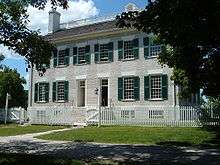 | Shakertown at Pleasant Hill | None | Pleasant Hill[nb 6] | Harrodsburg | Kentucky | 1806-1910[31][32] | NRHP[11] |
 | Shirley Shaker Village | Pleasant Garden | Harvard | Shirley | Massachusetts | 1793-1908[33][34] | NRHP[11] |
| Sodus Bay Shaker Village | None | New Lebanon | Sodus and Huron | New York | 1826-1836[35] | ||
 | South Union Shaker Village | Jasper Valley | South Union[nb 6] | South Union | Kentucky | 1807-1922[36][37] | NRHP[11] |
 | Tyringham Shaker Settlement | City of Love | Hancock | Tyringham | Massachusetts | 1792-1875[38][39] | NRHP[11] |
 | Union Village Shaker settlement | Wisdom's Paradise | Union Village[nb 6] | Turtlecreek Township | Ohio | 1805-1912[18][40][41] | |
 | Watervliet Shaker Village | Wisdom's Valley | New Lebanon | Albany | New York | 1774-1926[42] | NRHP[11] |
| Watervliet (Ohio) Shaker Village | Vale of Peace | Union Village[nb 6] | Kettering | Ohio | 1806-1900[40][43] | Historical marker[44] | |
| West Union Shaker village | None | Union Village | West Union (Busro) | Indiana | 1807-1827[8] | ||
| White Oak Shaker colony | None | Union Village | White Oak | Georgia | 1898-1902[18] | ||
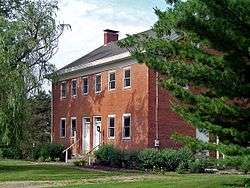 | Whitewater Shaker Settlement | Lonely Plain of Tribulation | Whitewater[nb 6] | New Haven | Ohio | 1822-1916[40][45] | NRHP[11] |
Out-families and short-lived missions
In addition to the organized communities, other, small "out-families" and very short-lived communities emerged during the history of the Shakers. These included:
- Numerous communities throughout New England: Cheshire, Ashfield, Richmond, Shelburne Falls, Turners Falls, Norton, Petersham, Grafton, Upton, and Rehoboth in Massachusetts; Windham, Preston, Stonington, and Saybrook, Connecticut; Guilford and Pittsford, Vermont; Tuftonboro, New Hampshire. These emerged during the 1780s but were eventually absorbed into the larger Shaker communities.[46][47][48][49]
- Two families in Canaan, New York. These began in 1813, and were part of the larger New Lebanon Village.[46]
- Poland Hill at Poland, Maine. This community, founded by the former residents of Gorham when that village closed, served as the North Family and Gathering Order of the Sabbathday Lake Shaker Village.
- A community in Darby Plains in Union County, Ohio, which existed from 1822-1823. Quickly abandoned, the Shakers there relocated to the Whitewater Settlement.[46]
- Missions to Straight Creek and Eagle Creek in Ohio.[46]
- A short-lived settlement at Red Banks, Kentucky.[46]
Shaker village tourism
In the 19th century, hundreds of tourists visited Shaker villages, and many of them later wrote about their experiences there. Outsiders were invariably impressed by Shaker cleanliness, prosperity, and agriculture. Shaker food was delicious, and they were hospitable to outsiders. Shakers had a reputation for honesty and their products were the best of their kind.[50]
Museums
- Alfred Shaker Museum, Alfred, Maine
- Canterbury Shaker Village, Canterbury, New Hampshire
- Enfield Shaker Museum, Enfield, New Hampshire
- Fruitlands Museum, Harvard, Massachusetts
- Hancock Shaker Village, Hancock, Massachusetts
- Pleasant Hill, Kentucky, Harrodsburg, Kentucky
- Sabbathday Lake Shaker Village, New Gloucester, Maine
- Shaker Historical Museum, Shaker Heights, Ohio
- Shaker Historical Society, Colonie, New York
- Shaker Museum and Library, New Lebanon, New York
- Shaker Museum at South Union, Auburn, Kentucky
Notes
- 1 2 The Alfred Bishopic was placed under the Canterbury Ministry from 1830 to 1859.[5]
- ↑ NRHP - National Register of Historic Places
- ↑ Groveland came under New Lebanon after 1859.[5]
- ↑ The Hancock Village spread out over Hancock, Pittsfield, and Richmond. In 1950, Eldress Francis Hall moved the Ministry from New Lebanon to Pittsfield.
- ↑ While the last Shakers left Narcoossee in 1924, it took until 1933 to successfully sell all the property
- 1 2 3 4 5 6 After 1862, North Union fell under Union Village. After 1889, Union Village oversaw all societies in Kentucky and Ohio.[5]
- ↑ Watervliet itself was part of the New Lebanon Bishopric, but the Philadelphia Shakers operated under the authority of the Watervliet Village
- ↑ Unique among Shaker communities, the Philadelphia Shakers were an urban community
- ↑ Some land retained until the 1880s
References
- ↑ Stephen J. Stein, The Shaker Experience in America (1992) pp 10–37
- ↑ Priscilla Brewer, Shaker Communities, Shaker Lives (Hanover, N.H.: University Press of New England, 1986), xx; Stephen J. Stein, The Shaker Experience in America, 114.
- ↑ Glendyne R. Wergland, One Shaker Life: Isaac Newton Youngs, 1793–1865 (Amherst: University of Massachusetts Press, 2006), chapter 2.
- ↑ Michael Duduit, Handbook of Contemporary Preaching (Nashville, TN: Broadman Press, 1992). 32–33.
- 1 2 3 4 5 Stephen J. Paterwic. Historical Dictionary of the Shakers. Scarecrow Press; 11 August 2008. ISBN 978-0-8108-6255-5. p. 18.
- ↑ Stein, The Shaker Experience in America p. 94.
- ↑ Stephen J. Stein. The Shaker Experience in America: A History of the United Society of Believers. Yale University Press; 1 February 1994. ISBN 978-0-300-05933-5. p. 181.
- 1 2 Stephen J. Paterwic. The A to Z of the Shakers. Scarecrow Press; 28 September 2009. ISBN 978-0-8108-7056-7. p. 235.
- ↑ Alfred Shaker Historic District. Shaker Historic Trail. National Park Service. Retrieved March 25, 2014.
- ↑ Stephen J. Paterwic. Historical Dictionary of the Shakers. Scarecrow Press; 11 August 2008. ISBN 978-0-8108-6255-5. p. 2.
- 1 2 3 4 5 6 7 8 9 10 11 12 13 14 15 List of Sites. Shaker Historic Trail: National Register of Historic Places Travel Itinerary. Retrieved March 27, 2014.
- ↑ Canterbury Shaker Village. Shaker Historic Trail. National Park Service. Retrieved March 25, 2014.
- ↑ Stephen J. Paterwic. The A to Z of the Shakers. Scarecrow Press; 28 September 2009. ISBN 978-0-8108-7056-7. p. 29.
- ↑ Enfield Shaker Historic District. Shaker Historic Trail. National Park Service. Retrieved March 25, 2014.
- ↑ Stephen J. Paterwic. The A to Z of the Shakers. Scarecrow Press; 28 September 2009. ISBN 978-0-8108-7056-7. p. 65.
- ↑ Enfield Shakers Historic District. Shaker Historic Trail. National Park Service. Retrieved March 25, 2014.
- ↑ Stephen J. Paterwic. The A to Z of the Shakers. Scarecrow Press; 28 September 2009. ISBN 978-0-8108-7056-7. p. 63.
- 1 2 3 4 5 6 Murray, Stuart (1994). Shaker Heritage Guidebook. Spencertown, New York: Golden Hill Press. p. 11. ISBN 0961487666.
- ↑ Stephen J. Paterwic. The A to Z of the Shakers. Scarecrow Press; 28 September 2009. ISBN 978-0-8108-7056-7. p. 96.
- ↑ Stephen J. Paterwic. The A to Z of the Shakers. Scarecrow Press; 28 September 2009. ISBN 978-0-8108-7056-7. p. 101.
- ↑ Harvard Shaker Village. Shaker Historic Trail. National Park Service. Retrieved March 25, 2014.
- ↑ Stephen J. Paterwic. The A to Z of the Shakers. Scarecrow Press; 28 September 2009. ISBN 978-0-8108-7056-7. p. 104.
- ↑ Mount Lebanon Shaker Society. Shaker Historic Trail. National Park Service. Retrieved March 25, 2014.
- ↑ North Union Shaker Site. Shaker Historic Trail. National Park Service. Retrieved March 25, 2014.
- ↑ "Claiming Their Citizenship: African American Women from 1624-2009". National Women's History Museum. Retrieved September 5, 2016.
- ↑ Danker, Anita C. (2005). Multicultural Social Studies: Using Local History in the Classroom. New York: Teachers College Press. p. 121. ISBN 9780807745854.
- ↑ Smith, Jessie Carney (2013). Black Firsts: 4,000 Ground-Breaking and Pioneering Historical Events. Canton, Michigan: Visible Ink Press. p. 603. ISBN 9781578594245.
- ↑ Paterwic, Stephen J. (2008). Historical Dictionary of the Shakers. Lanham, Maryland: Scarecrow Press. p. 171. ISBN 9780810862555.
- ↑ Sabbathday Lake Shaker Village. Shaker Historic Trail. National Park Service. Retrieved March 25, 2014.
- ↑ Stephen J. Paterwic. The A to Z of the Shakers. Scarecrow Press; 28 September 2009. ISBN 978-0-8108-7056-7. p. xx.
- ↑ Shakertown at Pleasant Hill Historic District. Shaker Historic Trail. National Park Service. Retrieved March 25, 2014.
- ↑ Stephen J. Paterwic. The A to Z of the Shakers. Scarecrow Press; 28 September 2009. ISBN 978-0-8108-7056-7. p. 174.
- ↑ Shirley Shaker Village. Shaker Historic Trail. National Park Service. Retrieved March 25, 2014.
- ↑ Stephen J. Paterwic. The A to Z of the Shakers. Scarecrow Press; 28 September 2009. ISBN 978-0-8108-7056-7. p. 191.
- ↑ Stephen J. Paterwic. The A to Z of the Shakers. Scarecrow Press; 28 September 2009. ISBN 978-0-8108-7056-7. p. 197.
- ↑ South Union Shakertown Historic District. Shaker Historic Trail. National Park Service. Retrieved March 25, 2014.
- ↑ Stephen J. Paterwic. The A to Z of the Shakers. Scarecrow Press; 28 September 2009. ISBN 978-0-8108-7056-7. p. 201.
- ↑ Tyringham Shaker Settlement Historic District. Shaker Historic Trail. National Park Service. Retrieved March 25, 2014.
- ↑ Stephen J. Paterwic. The A to Z of the Shakers. Scarecrow Press; 28 September 2009. ISBN 978-0-8108-7056-7. p. 218.
- 1 2 3 Whitewater Shaker Settlement. Shaker Historic Trail. National Park Service. Retrieved March 25, 2014. Archived from the original August 15, 2007.
- ↑ Stephen J. Paterwic. The A to Z of the Shakers. Scarecrow Press; 28 September 2009. ISBN 978-0-8108-7056-7. p. xxi.
- ↑ Watervliet Shaker Historic District. Shaker Historic Trail. National Park Service. Retrieved March 25, 2014.
- ↑ Stephen J. Paterwic. The A to Z of the Shakers. Scarecrow Press; 28 September 2009. ISBN 978-0-8108-7056-7. p. 229.
- ↑ Marker #6-57 Watervliet Shaker Community. Remarkable Ohio: Marking Ohio's History. The Ohio Historical Society. Retrieved March 26, 2014.
- ↑ Stephen J. Paterwic. The A to Z of the Shakers. Scarecrow Press; 28 September 2009. ISBN 978-0-8108-7056-7. p. xxi, xxiii.
- 1 2 3 4 5 Andrews, Edward Deming (1963). The People Called Shakers: A Search for the Perfect Society (2nd ed.). New York: Dover Publications. pp. 291–292. ISBN 978-0486210810.
- ↑ Stephen J. Stein, The Shaker Experience in America (1992), p 19
- ↑ Stephen J. Paterwic. The A to Z of the Shakers. Scarecrow Press; 28 September 2009. ISBN 978-0-8108-7056-7. p 141.
- ↑ Merchant, Carolyn (2010). Ecological Revolutions: Nature, Gender, and Science in New England. Chapel Hill: University of North Carolina Press. p. 248. ISBN 9780807899625.
- ↑ Glendyne R. Wergland, Visiting the Shakers, 1778–1849; Glendyne R. Wergland, Visiting the Shakers, 1850–1899 (Clinton, N.Y.: Richard W. Couper Press, 2010).
Further reading
- Brewer, Priscilla. Shaker Communities, Shaker Lives. Hanover, N.H.: University Press of New England, 1986.
- Brewer, Priscilla. "The Shakers of Mother Ann Lee," in America's Communal Utopias ed. by Donald E. Pitzer. (1997) pp. 37–56.
- Burns, Deborah E. Shaker Cities of Peace, Love, and Union: A History of the Hancock Bishopric. U. Press of New England, 1993. 246 pp.
- Foster, Lawrence. Women, Family, and Utopia: Communal Experiments of the Shakers, the Oneida Community, and the Mormons (1991).
- Gutek, Gerald and Gutek, Patricia. Visiting Utopian Communities: A Guide to the Shakers, Moravians, and Others. U. of South Carolina Press, 1998. 230 pp.
- Kelly, Andrew. Kentucky by Design: The Decorative Arts and American Culture, with an Emphasis on the Shaker Communities at Pleasant Hill and South Union. University Press of Kentucky, 2015. ISBN 978-0-8131-5567-8
- Murray, John E. “A Demographic Analysis of Shaker Mortality Trends.” Communal Societies. Volume 13 (1993): 22–44.
- Murray John E. "Determinants of Membership Levels and Duration in a Shaker Commune, 1780–1880". Journal for the Scientific Study of Religion 34 (1995): 35–48. In JSTOR
- Murray, John E. “The white plague in utopia: tuberculosis in nineteenth-century Shaker communes.” Bulletin of the History of Medicine: 1994, volume 68: 278–306; erratum, 510.
- Paterwic, Stephen. “From Individual to Community: Becoming a Shaker at New Lebanon, 1780–1947.” Communal Societies, Volume 11 (1991): 18–33.
- Paterwic, Stephen J. “Mysteries of the Tyringham Shakers Unmasked: A New Examination of People, Facts, and Figures.” Historical Journal of Massachusetts. (Winter 2003).
- Portman, Rob and Cheryl Bauer. Wisdom's Paradise: The Forgotten Shakers of Union Village. Wilmington, Ohio: Orange Frazer Press, 2004. ISBN 1-882203-40-2. (About the Warren County, Ohio settlement.)
- Pushkar-Pasewicz, Margaret. “Kitchen Sisters and Disagreeable Boys: Debates over Meatless Diets in Nineteenth-Century Shaker Communities.” in Eating in Eden: Food and American Utopias. Etta M. Madden and Martha L. Finch, eds. University of Nebraska Press, 2006. pp. 109–24.
- Rotundo, Barbara. “Crossing the Dark River: Shaker Funerals and Cemeteries.” Communal Societies. Volume 7 (1987): 36–46.
- Sasson, Diane. “Individual Experience, Community Control, and Gender: The Harvard Shaker Community During the Era of Manifestations,” Communal Societies 13 (1993): 45–70.
- Sprigg, June. Simple Gifts: Lessons in Living from a Shaker Village. New York: Random House, 1998.
- Stiles, Lauren A. “‘Rather Than Ever Milk Again’: Shaker Sisters’ Refusal to Milk at Mount Lebanon and Watervliet—1873–1877.” American Communal Societies Quarterly. Volume 3.1 (2009):13–25.
- Thurman, Suzanne R. "O Sisters Ain't You Happy?": Gender, Family, and Community among the Harvard and Shirley Shakers, 1781–1918. Syracuse University Press, 2002. pp. 262.
- Thurman, Suzanne. “‘No idle hands are seen’: The Social Construction of Work in Shaker Society.” Communal Societies. Volume 18 (1998): 36–52.
- Wertkin, Gerard C. The Four Seasons of Shaker Life: An Intimate Portrait of the Community at Sabbathday Lake. Photographs by Ann Chwasky. Simon & Schuster, 1986. pp. 189
External links
- Settlements
- Alfred Shaker Village, Alfred, Maine
- Canterbury Shaker Village, Canterbury, New Hampshire
- Enfield Shaker Village, Enfield, New Hampshire, Enfield Shaker Singers, Enfield, New Hampshire
- Hancock Shaker Village, Hancock, Massachusetts
- Shaker Museum|Mount Lebanon, New Lebanon, New York
- Pleasant Hill Shaker Village, Pleasant Hill, Kentucky
- Sabbath Day Lake Shakers, Maine, Interview of the Sabbath Day Lake Shakers, Sabbath Day Lake Shaker Library and Museum
- Shirley Shaker Village, Shirley, Massachusetts
- South Union Shaker Village, South Union, Kentucky
- Whitewater Shaker Village, Whitewater, Ohio (site dead)